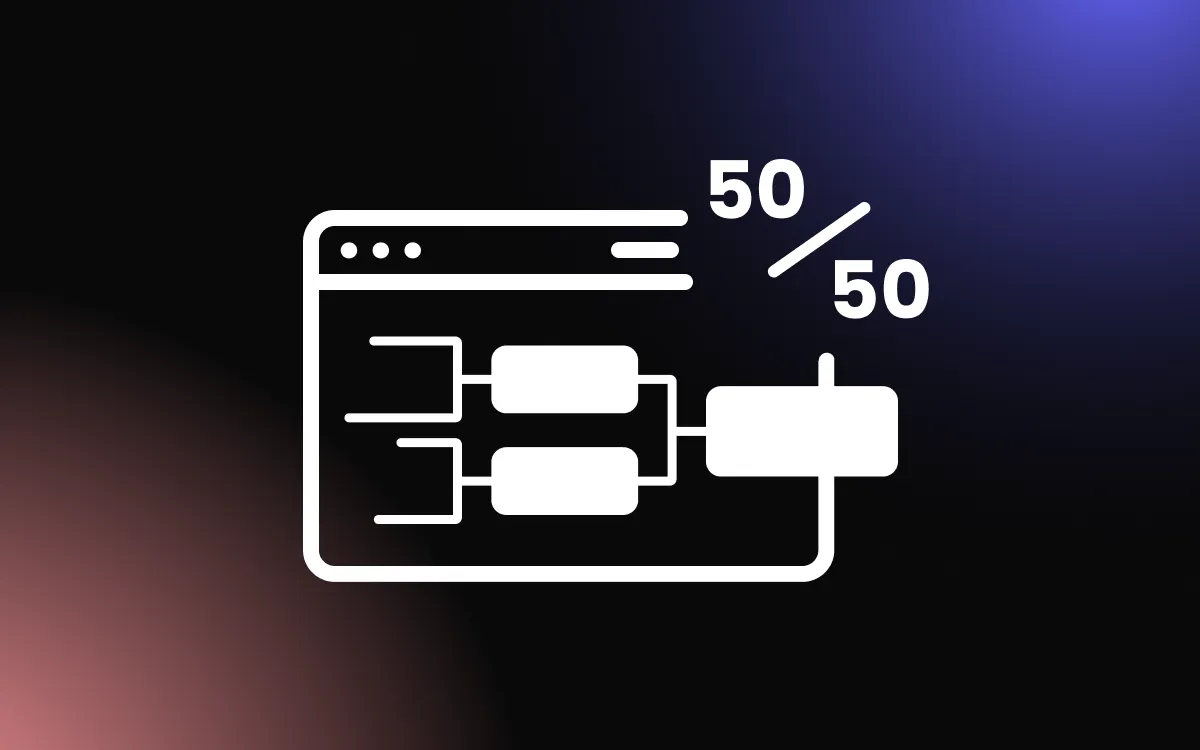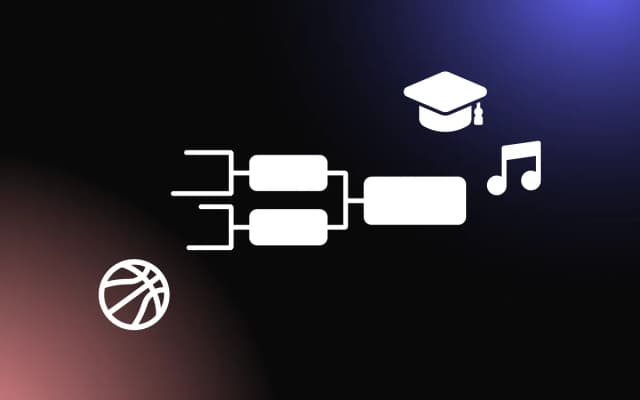Summary (TL;DR): In this article, we explore the allure of prediction brackets and their role in engaging audiences. From choosing a captivating theme to designing user-friendly layouts, we guide you through setting up and promoting your challenge. Emphasis is placed on ensuring fairness, celebrating winners, and maintaining participant engagement. Tips and best practices round out our comprehensive guide to mastering prediction bracket challenges.

Prediction bracket challenges have become synonymous with friendly competition, strategic thinking, and the sheer joy of the unpredictable. Whether it's the frenzy of March Madness or any other tournament, these challenges offer participants a chance to pit their knowledge, intuition, and luck against each other.
But creating an engaging prediction bracket challenge goes beyond just setting up a bracket. It requires careful planning, enticing incentives, and interactive elements to keep participants hooked.
This guide will walk you through the steps and considerations to create a prediction bracket challenge that not only sparks interest but also sustains engagement throughout the tournament.
Understanding the Basics of Prediction Brackets
What is a Prediction Bracket Challenge?
A Prediction Bracket Challenge is a popular form of competition, especially during sports tournaments, where participants attempt to predict the outcome of each game in the tournament bracket.
Originating from the NCAA Men's Basketball Tournament, colloquially known as "March Madness," the concept has since expanded to various other sports and events. Participants fill out a bracket, forecasting which teams (or individuals) they believe will win each match-up, progressing through the rounds until selecting a champion.
The challenge typically works as follows:
- Selection: Before the tournament begins, participants receive a blank bracket with all the initial match-ups.
- Prediction: Participants predict the winner of each game, filling out the entire bracket up to the championship.
- Scoring: Points are awarded for each correct prediction, with the point value often increasing in the later rounds.
- Winner Determination: At the end of the tournament, the participant with the most points, indicating the most accurate predictions, is declared the winner.
Why are Brackets So Engaging?
- Simplicity: The bracket format is visually straightforward, making it easy for even casual fans to understand and participate.
- Personal Investment: Filling out a bracket creates a personal stake in the tournament's outcomes, even if one's favorite team isn't participating. Every game becomes significant as it can impact the participant's bracket standings.
- Friendly Competition: Bracket challenges are often organized among friends, family, or coworkers, adding a layer of friendly rivalry. The desire to out-predict peers adds to the excitement.
- Unpredictability: Sports, by nature, are unpredictable. The possibility of upsets means that even someone with limited knowledge has a chance to win, making the challenge inclusive.
- Endless Discussion: Brackets provide endless fodder for discussion, debate, and analysis. From defending one's choices to discussing potential upsets, it becomes a focal point of conversation.
Defining the Theme and Scope
Choosing a Relevant and Exciting Topic
Every successful Prediction Bracket Challenge begins with a compelling topic. The theme should resonate with the target audience and spark enthusiasm. While sports tournaments are the most common, the sky's the limit when it comes to potential subjects.
From pop culture battles like "Best Movie of the Decade" to culinary face-offs such as "Ultimate Dessert Showdown," the key is to select a topic that participants will be passionate about.
When choosing a theme, consider:
- Trending Topics: What's currently popular or relevant in the news or culture? Capitalizing on current events or trends can boost participation.
- Audience Interests: Know your audience. If targeting a specific group, like movie buffs or food enthusiasts, tailor the theme to their interests.
- Debate Potential: The best topics are those that can spark friendly debates and discussions. If people are likely to have strong opinions on the subject, it's a good sign.
Deciding on the Number of Entries or Teams
The number of entries determines the size and complexity of the bracket. While a traditional sports bracket might have 64 teams, other challenges can be more flexible. Here are some factors to consider:
- Engagement Level: A larger bracket might engage participants for a longer time, but it also demands more commitment. A smaller bracket might be more accessible but could end too quickly.
- Topic Depth: Some themes might not support a large number of entries without diluting the quality. For instance, a "Best Rock Bands of the 90s" bracket might be limited to 32 or even 16 bands to ensure only iconic groups are included.
- Duration: If the challenge is meant to last several weeks, a larger bracket might be appropriate. For shorter durations, consider fewer entries.
Setting the Duration and Timeline of the Challenge
The timeline is crucial for maintaining momentum and interest. Here's how to approach it:
- Kick-off: Announce the challenge well in advance, giving participants ample time to prepare and anticipate. This build-up can create buzz and increase participation.
- Voting Period: Decide how long each round will last. Typically, each round might last a week, but this can be adjusted based on the overall timeline and number of entries.
- Updates: Regularly update participants on the progress of the challenge. This can be done after each round, highlighting which entries advanced and any upcoming match-ups.
- Conclusion: Once the challenge concludes, promptly announce the winner. Consider hosting a wrap-up event or discussion, allowing participants to reflect on the results and share their thoughts.
Designing the Bracket Layout
Traditional vs. Creative Layouts
When it comes to bracket layouts, there's the tried-and-true traditional format and then there's the road less traveled: creative layouts. The traditional layout, often seen in sports tournaments, is a straightforward, tree-like structure that clearly delineates each round until the final showdown. It's familiar, easy to follow, and universally recognized.
However, for those looking to add a unique twist or cater to a specific theme, creative layouts can be an exciting alternative. For instance, a music-themed bracket might resemble a vinyl record, or a culinary challenge could take the shape of a dining table. While these designs can be visually appealing and memorable, it's essential to ensure they don't compromise the bracket's clarity.
The Best Prediction Bracket Maker

Harnessing the power of visual tools, we proudly present the Common Ninja’s Brackets widget as the pinnacle of prediction bracket creation. Our tool is meticulously designed to empower users to craft, tailor, and integrate brackets for a myriad of events, from sports tournaments to gaming showdowns.
With our widget, predicting outcomes becomes an engaging and streamlined process. The blend of its intuitive design and adaptability ensures that it stands out, making it an indispensable asset for anyone seeking a reliable and efficient prediction bracket solution.
Ensuring Clarity and User-Friendliness
Regardless of the chosen layout or design tool, the primary goal should always be clarity. Participants should easily understand the progression, matchups, and results. Here are some tips:
- Legible Text: Ensure team names, numbers, or any other relevant information are easily readable.
- Clear Progression: Each round should be distinctly marked, and the flow from one round to the next should be intuitive.
- Interactive Elements: If the bracket is digital, consider adding interactive elements like tooltips for more information or clickable areas for voting.
- Consistent Design: Maintain a consistent color scheme, font, and design style throughout the bracket for a cohesive look.
Setting Up the Prediction Mechanism
Online Platforms vs. Physical Submission
In the age of technology, prediction brackets have evolved from pen-and-paper submissions to sophisticated online platforms. Both methods have their merits.
Online Platforms (like Common Ninja): These are becoming increasingly popular due to their convenience and efficiency. Participants can submit their predictions with a few clicks, and organizers can easily compile and analyze the data.
Physical Submission: While seemingly old-fashioned, there's a tangible excitement in filling out a paper bracket. Physical submissions can be ideal for localized events, like office pools or family gatherings. They offer a personal touch and can be displayed, creating a visual representation of participants' predictions.
Incorporating Real-time Updates and Scoring
As the event progresses, participants will be eager to see how their predictions fare. Incorporating real-time updates is crucial for maintaining engagement.
- Automated Scoring Systems: Many online platforms offer automated scoring, updating points as results come in. This feature reduces manual work and ensures accuracy.
- Live Leaderboards: Displaying a live leaderboard can stoke competitive spirits. Participants can see where they stand compared to others, adding an element of excitement.
- Notification Systems: Consider sending out notifications for major upsets, close calls, or when participants climb the leaderboard. This keeps the event at the forefront of participants' minds.
Ensuring Fair Play and Transparency
With any competition, ensuring fairness is paramount. Here's how to maintain integrity:
- Clear Rules: From the outset, establish clear rules about submission deadlines, scoring systems, and any other relevant details. This ensures everyone is on the same page.
- Anti-Cheat Measures: For online platforms, incorporate measures to prevent multiple submissions from the same user. For physical brackets, have a designated drop-off point and a strict submission deadline.
- Transparency in Scoring: Make sure participants understand how scoring works. Consider publishing interim scores at various stages of the event.
- Dispute Resolution: Have a system in place to handle disputes. Whether it's a questionable submission or a scoring query, addressing it promptly and fairly is essential.
Promoting and Marketing the Challenge

Utilizing Social Media for Viral Engagement
In today's digital age, social media is a powerful tool for promoting any event, including a prediction bracket challenge. Here's how to leverage it:
- Hashtags: Create a unique and catchy hashtag for your challenge. This not only brands your event but also makes it easier for participants to share and follow related posts.
- Engaging Content: Share teaser videos, behind-the-scenes looks, and countdowns to build anticipation. Use visually appealing graphics and interactive polls to engage your audience.
- Shareable Brackets (a feature that Common Ninja’s Bracket Maker offers): Design your brackets in a way that participants will want to share them on their profiles, showcasing their predictions and encouraging friends to join.
- Live Updates: Use platforms like Twitter or Instagram Stories for real-time updates, keeping the excitement alive throughout the challenge.
Collaborating with Influencers or Celebrities
Influencers and celebrities can give your challenge a significant boost in visibility:
- Choose the Right Fit: Collaborate with personalities who resonate with your target audience and the theme of your bracket.
- Guest Predictions: Invite them to share their own brackets or predictions, which can encourage their followers to participate.
- Exclusive Content: Offer influencers exclusive content or behind-the-scenes access, which they can share with their audience, creating buzz around your challenge.
- Engage in Friendly Competitions: Pit influencers against each other in a friendly rivalry, encouraging their respective fan bases to join in on the fun.
Offering Incentives and Prizes for Participation
Incentives can be a driving force for participation:
- Tangible Rewards: Offer prizes for top predictors. This could be monetary, merchandise, tickets to related events, or exclusive experiences.
- Recognition: Apart from physical prizes, recognizing top participants on your platform or social media can be a significant incentive. Everyone appreciates a moment in the spotlight.
- Tiered Rewards: Instead of just rewarding the top predictor, consider having tiered rewards. This ensures that even if someone feels they might not win the top prize, there are still other rewards within reach.
- Early Bird Incentives: Offer special rewards or additional points for those who register or submit their predictions early. This can drive quick initial participation and set the momentum for the challenge.
Engaging Participants Throughout the Challenge

Providing Regular Updates and Leaderboards
Keeping participants informed is crucial to maintaining their interest throughout the challenge:
- Dynamic Leaderboards: Implement real-time leaderboards that update as scores change. This not only fuels the competitive spirit but also gives participants a clear view of where they stand.
- Notification Systems: Use email notifications, app alerts, or SMS to inform participants of major shifts in rankings, upcoming deadlines, or unexpected turn of events in the bracket.
- Milestones and Highlights: Celebrate and communicate significant milestones, be it a participant achieving a perfect score so far or an unexpected outcome in the bracket that affects many predictions.
Hosting Live Events or Discussions Related to the Bracket
Live events can significantly boost engagement:
- Webinars and Live Streams: Host live discussions or analysis sessions where experts break down the events that are shaping the bracket. This not only educates participants but also builds a sense of community.
- Q&A Sessions: Allow participants to interact with experts or influencers, asking questions or discussing strategies related to the bracket.
- Virtual Watch Parties: If the bracket challenge is based on live events, like sports matches or award shows, hosting virtual watch parties can be a fun way to bring participants together.
Encouraging Social Sharing and Community Building
A sense of community can make participants more invested in the challenge:
- User-Generated Content: Encourage participants to share their predictions, reactions, or strategies on social media. Highlight and reward the best content to motivate others.
- Discussion Forums: Create platforms or forums where participants can discuss, debate, and share their insights related to the bracket. This not only keeps them engaged but also fosters a sense of belonging.
- Team Challenges: Allow participants to form teams or groups. Competing as a team can be more engaging than competing individually, and it encourages collaboration and discussion among team members.
Handling Results and Recognizing Winners
Setting Clear Criteria for Winning
For any prediction bracket challenge, clarity is paramount. Participants need to know exactly what they're aiming for:
- Scoring System: Clearly define how points are awarded. Is it a simple system where each correct prediction earns a point, or are there multipliers for later rounds? Maybe there are bonus points for predicting upsets.
- Tie-Breakers: In the event of a tie, how will winners be determined? Common tie-breakers might include predicting the final score of a championship game or the total number of points scored across all matches.
- Transparency: Ensure that the scoring process is transparent. Participants should be able to track their scores and understand any calculations.
Celebrating Winners Publicly and Offering Prizes
Recognition is a significant part of any competition:
- Announcement Platforms: Use social media, emails, and the challenge's website to announce winners. A live announcement can add excitement and anticipation.
- Prizes: Offer tangible rewards for the top predictors. This could range from monetary prizes, merchandise, tickets to related events, or even exclusive experiences.
- Certificates or Badges: Digital certificates or badges can be a cost-effective way to recognize participants. These can be shared on social media, adding to the winner's sense of achievement.
Gathering Feedback for Future Challenges
Continuous improvement is key to the success of recurring bracket challenges:
- Feedback Surveys: Shortly after the challenge concludes, send out surveys to gather feedback. Ask participants what they liked, what they didn't, and what could be improved.
- Engage in Discussions: Use forums or social media platforms to engage with participants. Direct conversations can provide insights that structured surveys might miss.
- Implement Changes: Actively use the feedback to make improvements. And importantly, let participants know that their feedback was heard and acted upon in the next iteration.
Tips and Best Practices
Ensuring Accessibility and Inclusivity
In the digital age, ensuring that everyone can participate in your bracket challenge is crucial:
- User-Friendly Design: Ensure that your online platform is easy to navigate, with intuitive interfaces. This will cater to participants of all tech-savviness levels.
- Mobile Optimization: With many users accessing online content via mobile devices, ensure your bracket challenge is mobile-friendly.
- Language and Cultural Considerations: If your challenge has a global audience, consider offering multiple language options or culturally relevant content.
Preparing for Potential Controversies or Disputes
Controversies can arise, especially in competitive settings:
- Clear Rules: From the outset, have a comprehensive set of rules and guidelines. This minimizes ambiguity and provides a reference point in case of disputes.
- Neutral Adjudication: Consider setting up a neutral panel or system to handle disputes. Their decisions should be final, ensuring the process remains fair.
- Open Communication Channels: Allow participants to raise concerns or seek clarifications. This can be through a dedicated email, chat support, or a forum.
Keeping the Momentum Going with Follow-Up Events or Challenges
To ensure sustained engagement:
- Feedback Loop: After the challenge, engage with participants to get feedback. This not only provides valuable insights but also makes participants feel valued.
- Regular Updates: Even after the main event, keep participants updated with news, stats, or related content. This keeps the community engaged and looking forward to the next challenge.
- Sequel Events: Consider organizing follow-up challenges or related events. For instance, if the initial challenge was about predicting winners, a follow-up could be about the best moments or plays.
Conclusion
In conclusion, an engaging prediction bracket challenge is a blend of strategy, community engagement, and the thrill of competition. It's about offering participants a platform to showcase their expertise, make bold predictions, and revel in the camaraderie of shared experiences.
Remember, the success of a bracket challenge isn't just measured by the number of participants, but by the conversations, excitement, and memories it generates. With the insights and strategies shared in this article, you're now equipped to craft a prediction bracket challenge that captivates, engages, and becomes the highlight of the tournament season. So, gather your community, set the stakes, and let the predictions roll in!







